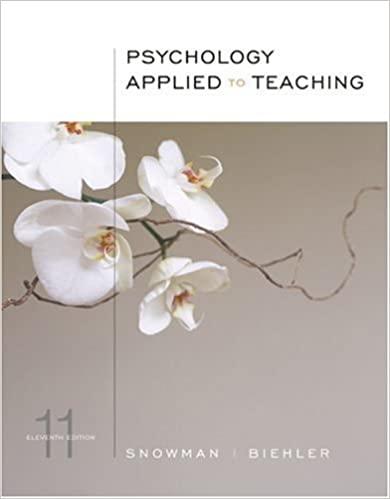Question
1. Which factor in planning can make the biggest difference between a successful family learning event and chaos? a. gathering materials ahead of time b.
1. Which factor in planning can make the biggest difference between a successful family learning event and chaos?
a. gathering materials ahead of time
b. inviting families to attend
c. creating engaging activities
d. preparing school facilitators to assist
2. When using learning stations for interactive family events, what should Miss Schlofer do to help families feel more comfortable during the activities?
a. use structured activities that can be completed in only one way
b. provide written directions at each station to guide families
c. plan activities that require families to watch their children participate
d. put facilitators at each station to help participants complete the activities
3. Schools can solicit honest family feedback after family events if exit surveys include ________.
a. a place for suggestions
b. a simple yes/no format
c. a prize for completion
d. identifying information
4. Mrs. Flores is the chairperson of her child's elementary school Family Event Planning Committee. This year, the committee is planning two transition events--one at the beginning of the year and one at the end of the year for the families of students moving up to middle school. Mrs. Flores recognizes that most families will attend these events because they desire _________.
a. contact with other parents who can help with carpooling and other similar duties
b. information about the school and the transition process
c. emotional support needed for smooth transitions
d. affirmation from teachers that they are caring parents
5. After a workshop on culturally responsive family engagement, the second-grade teachers at Lincoln Elementary decided to revamp their annual Chinese New Year family lunch. Although students and families seemed to enjoy the meal of lo main, tea, and fortune cookies, the teachers thought the event reflected a _________ because it emphasized cultural artifacts rather than the lived experiences of the members of the culture.
a. deficit approach
b. school-based focus
c. tourist curriculum
d. monocultural view
6. The only objectives teachers should have for family events are that they are casual and focus on family interactions and social networking.
a. True
b. False
7. Back-to-school events are examples of inauthentic and "one-shot" family fun events.
a. True
b. False
8. Teachers can schedule planning meetings at off-school sites to encourage greater family participation in event planning.
a. True
b. False
9. Establishing school lending libraries may be inexpensive, but they are not as effective for encouraging ongoing home literacy activities as providing free books to families.
a. True
b. False
10. Self-efficacy is encouraged when families who live in poverty are assisted in paying the fees associated with their children's participation in sports or other enrichment activities.
a. True
b. False
Step by Step Solution
There are 3 Steps involved in it
Step: 1

Get Instant Access to Expert-Tailored Solutions
See step-by-step solutions with expert insights and AI powered tools for academic success
Step: 2

Step: 3

Ace Your Homework with AI
Get the answers you need in no time with our AI-driven, step-by-step assistance
Get Started


